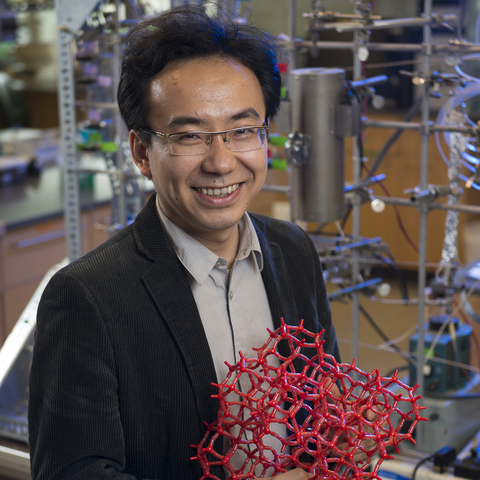An interdisciplinary team of UMass Amherst researchers had their recently published article chosen as a “hot” article in the journal Physical Chemistry Chemical Physics. The team, led by chemistry professor Scott Auerbach and chemical engineering professor Wei Fan, reported breakthrough computer simulations confirmed by experiments showing faster crystallization of nanoporous catalysts known as zeolites.

“Understanding how to make zeolites, and how to make them faster, is incredibly important. Zeolites are the most used synthetic catalysts on planet earth, and they show great potential for making green fuels and capturing carbon dioxide – both critical for battling climate change,” said Auerbach.
The team also includes lead author Cecilia Bores, a former postdoctoral fellow at UMass Amherst and now a physics professor at Union College, as well as chemical engineering Ph.D. student Song Luo and undergraduate researchers J. David Lonergan, Eden Richardson and Alexander Engstrom.
“Simulating zeolite crystallization is one of the grand challenges in materials science because the process can take days to weeks, so our simulations have to efficiently model very slow assembly processes,” said Bores. She continued, “The key to our work is capturing only the essential aspects of zeolite bonding and intentionally omitting some interactions between particles that would only slow down the simulation.”
Also critical to the work are experimental tests confirming that the simulation predictions are correct. Such experiments, carried out by Fan and Luo, involve using additives called “structure directing agents” to help steer the crystallization. Fan and Luo confirmed the prediction that using multiple structure directing agents that match the different nanopore sizes within a zeolite can speed up crystallization, by as much as a factor of three.

“Learning how faster zeolite crystallization occurs by using several structure directing agents is a real breakthrough for my lab,” said Fan. “We spend countless hours trying to fabricate new zeolites, so being able to speed up the process can lead to much faster discovery of new and useful materials.”
The team plans to continue the research, which is funded by the Department of Energy’s program in Synthesis and Processing Science, by applying artificial intelligence to analyze the simulated crystallization trajectories to identify key steps that lead to crystals, and by testing those predictions using advanced experimental methods such as Raman spectroscopy.
“Being able to combine computer simulations with experiments so seamlessly is critical to this research,” said Auerbach. “Our collaboration with Wei Fan and his team has been fantastic. As we like to say: ‘Without Wei, there’s no way!’"